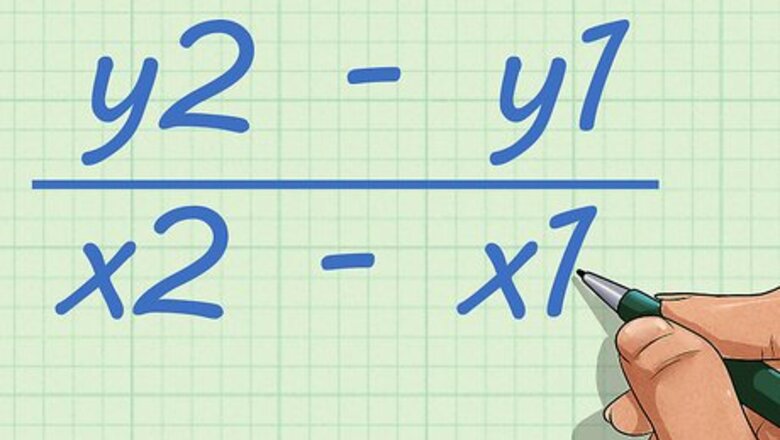
views
X
Research source
which is found be determining how many units the line moves vertically per how many units it moves horizontally. You can easily calculate the slope of a line using the coordinates of two of its points.
Setting up the Problem
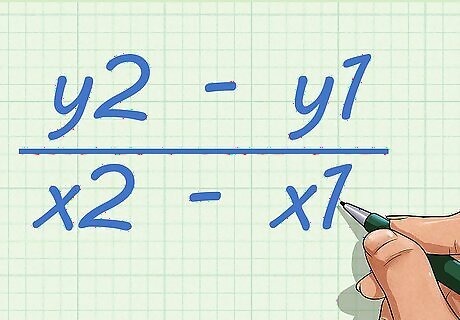
Understand the slope formula. Slope is defined as “rise over run,” with rise indicating vertical distance between two points, and run indicating the horizontal distance between two points.
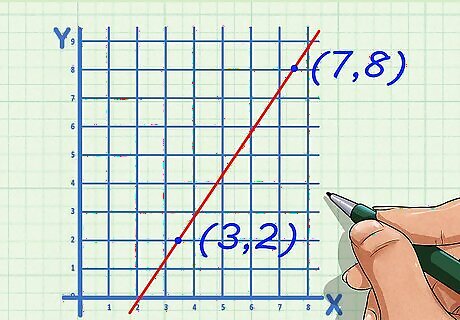
Pick two points on the line and label their coordinates. These can be any points the line runs through. You can also use this method if you are given two points on the line, without having the line graphed in front of you. Coordinates are listed as ( x , y ) {\displaystyle (x,y)} (x,y), with x {\displaystyle x} x being the location along the x, or horizontal axis, and y {\displaystyle y} y being the location along the y, or vertical axis. For example, you might choose points with coordinates ( 3 , 2 ) {\displaystyle (3,2)} (3,2) and ( 7 , 8 ) {\displaystyle (7,8)} (7,8).
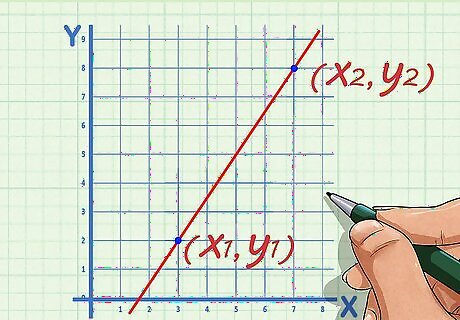
Determine the order of your points. One point will be point 1, and one point will be point 2. It doesn’t matter which point is which, as long as you keep them in the correct order throughout the calculation. The first point’s coordinates will be ( x 1 , y 1 ) {\displaystyle (x_{1},y_{1})} (x_{{1}},y_{{1}}), and the second point’s coordinates will be ( x 2 , y 2 ) {\displaystyle (x_{2},y_{2})} (x_{{2}},y_{{2}})
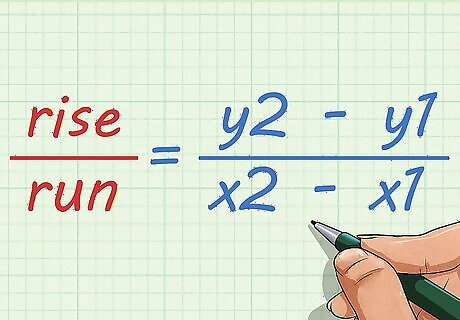
Set up the slope formula. The formula is r i s e r u n = y 2 − y 1 x 2 − x 1 {\displaystyle {\frac {rise}{run}}={\frac {y_{2}-y_{1}}{x_{2}-x_{1}}}} {\frac {rise}{run}}={\frac {y_{{2}}-y_{{1}}}{x_{{2}}-x_{{1}}}}. The change in y-coordinates determines the rise, and the change in x-coordinates determines the run.
Finding the Rise and Run
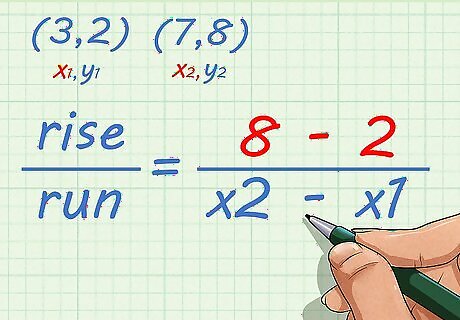
Plug the y-coordinates into the slope formula. Make sure you are not using the x-coordinates, and that you are substituting the correct y-coordinates for the first and second points. For example, if the coordinates of your first point are ( 3 , 2 ) {\displaystyle (3,2)} (3,2), and the coordinates of your second point are ( 7 , 8 ) {\displaystyle (7,8)} (7,8), your formula will look like this: r i s e r u n = 8 − 2 x 2 − x 1 {\displaystyle {\frac {rise}{run}}={\frac {8-2}{x_{2}-x_{1}}}} {\frac {rise}{run}}={\frac {8-2}{x_{{2}}-x_{{1}}}}
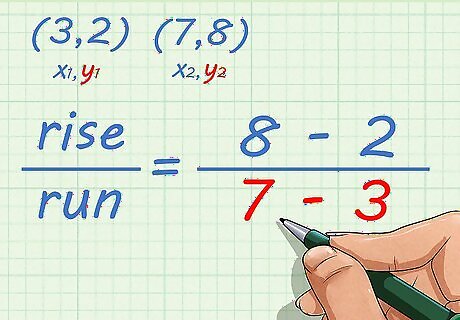
Plug the x-coordinates into the slope formula. Make sure you are not using the y-coordinates, and that you are substituting the correct x-coordinates for the first and second points. For example, if the coordinates of your first point are ( 3 , 2 ) {\displaystyle (3,2)} (3,2), and the coordinates of your second point are ( 7 , 8 ) {\displaystyle (7,8)} (7,8), your formula will look like this: r i s e r u n = 8 − 2 7 − 3 {\displaystyle {\frac {rise}{run}}={\frac {8-2}{7-3}}} {\frac {rise}{run}}={\frac {8-2}{7-3}}
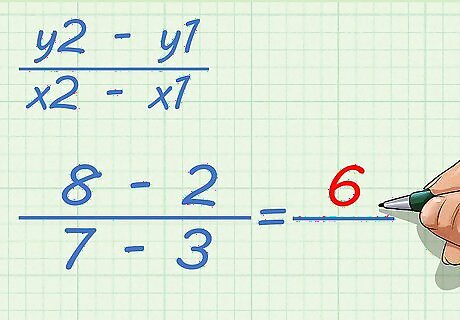
Subtract the y-coordinates. This will give you your rise. For example, if your y-coordinates are 8 {\displaystyle 8} 8 and 2 {\displaystyle 2} 2, you would calculate 8 − 2 = 6 {\displaystyle 8-2=6} 8-2=6.
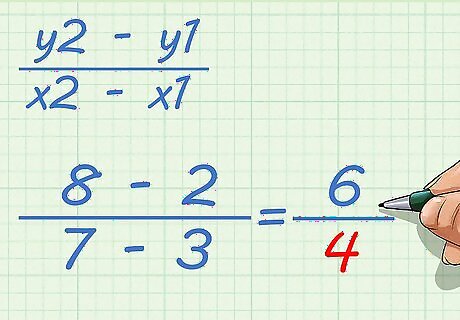
Subtract the x-coordinates. This will give you your run. For example, if your x-coordinates are 7 {\displaystyle 7} 7 and 3 {\displaystyle 3} 3, you would calculate 7 − 3 = 4 {\displaystyle 7-3=4} 7-3=4.
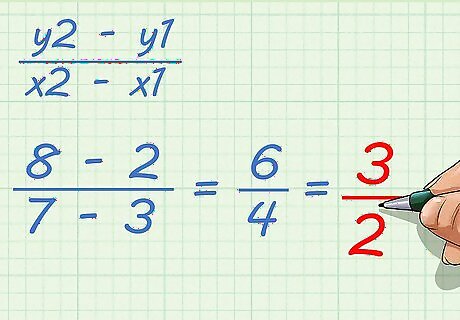
Reduce the fraction if necessary. This result will give you the slope of your line. For complete instructions on how to reduce a fraction, read Reduce Fractions. For example, 6 4 {\displaystyle {\frac {6}{4}}} {\frac {6}{4}} can be reduced to 3 2 {\displaystyle {\frac {3}{2}}} {\frac {3}{2}}, so the slope of a line through points ( 3 , 2 ) {\displaystyle (3,2)} (3,2) and ( 7 , 8 ) {\displaystyle (7,8)} (7,8) is 3 2 {\displaystyle {\frac {3}{2}}} {\frac {3}{2}}.
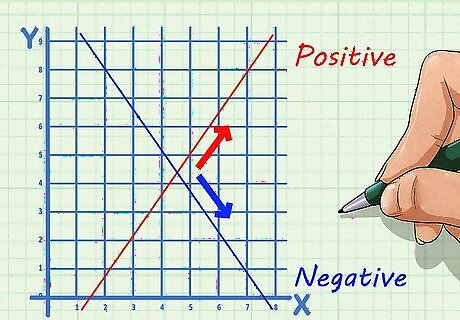
Be careful when working with negative numbers. A slope can be positive or negative. A line with a positive slope moves up left-to-right; a line with a negative slope moves down left-to-right. Remember, if the numerator and denominator are both negative, then the negative signs cancel out, and the fraction (and slope) is positive. If either the numerator or the denominator is negative, then the fraction (and slope) is negative.

Check your work. To do this, look at the rise and run you calculated for your slope. Starting at your first point, count up the rise, then over the run. Repeat counting up the rise and over the run until you reach your second point. If you do not reach your second point, then your calculation is incorrect.




















Comments
0 comment